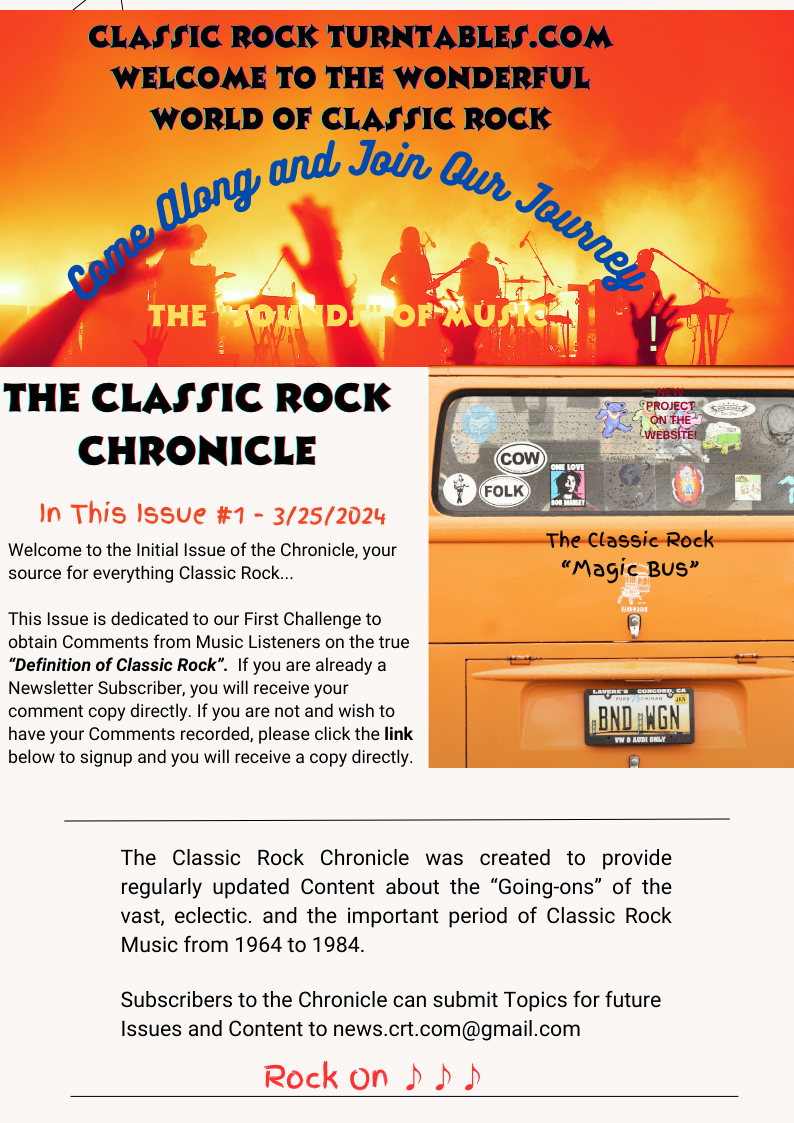

This Issue of the Chronicle, we present Part #7A-1 (The "Roaring 20s") of our 12-part series of the "History of the Sounds of Modern Music." Our objective is to follow the Sounds made by innovative Humans and their Instruments that have evolved throughout the Centuries of Man-on-Earth.
Part #1 - Early Civilizations Part #2 - Pre Civil War
Part #3 - Civil War and Post Part #4 -New Orleans Scene
Part #5 - The River Boat Era Part #6- The Big Cities
Part #7A - The Roaring 20s Part #7B - The Swing Era
Part #8 - Post World War II Part #9 - The 1950s
Part #9 - The 1960s Part #10 - Woodstock Era
Part #11 - The 1970s Part #12 - The 1980s
The Classic Rock Chronicle
I Issue #13 July 6, 2024
Everything Classic Rock... the CRocker's Voice
The Classic Rock Chronicle was created to provide regularly updated Content about the "Goings-on" of the Vast, eclectic, and important period of Classic Rock from 1964 to 1984... Come along and enjoy the ride, Mates
Subscribers to The Chronicle can submit Topics for future Issues and Content to news@classicrockturntables.com
History of the “Sounds” of Music Part #7A
The "Roaring 20s" Evolution of the Sounds of Music
By William W. Nelson
Founder of the Asheville School of Classic Rock
************
Introduction
In Part #7A, we will cover the "Roaring Twenties" period before the "Great Depression" in 1929... it was a period of economic prosperity with a distinctive cultural edge in the United States and Europe... that would greatly influence the evolution of People's tastes in Music, Libation, and Fashion... including the formalization of something called "Jazz" and the introduction of "Swing Jazz".
The Social and Cultural features known as the "Roaring Twenties" began in leading Metropolitan Centers (Chicago and New York City) and spread widely in the aftermath of World War I. Its spirit was marked by a general feeling of Novelty associated with and a break with tradition. Formal decorative frills were shed in favor of practicality in both daily Life and Architecture. At the same time, Jazz and Dancing rose in popularity, in opposition to the mood of World War I. As such, the period is called the "Jazz Age."
Jazz Music became wildly popular in the “Roaring Twenties,” a decade that witnessed unprecedented economic growth and prosperity in the United States. Consumer culture flourished, with ever greater numbers of Americans purchasing Automobiles, Electrical Appliances, and other widely available consumer products. The achievement of material affluence became a goal for many US citizens as well as an object of satire and ridicule for the writers and intellectuals of the "Lost Generation."
Technological innovations like the telephone and radio irrevocably altered the social lives of Americans while transforming the entertainment industry. Suddenly, Musicians could create Phonograph recordings of their Compositions. For Jazz Music, which was improvisational, the development of Phonograph technology was transformative. Whereas previously, Music lovers would actually have to attend a Nightclub or Concert Venue to hear Jazz, now they could listen on the Radio or even purchase their favorite recordings for at-home listening.
Note: This is the first of 3 "Paradime Shifts" in the History of the Sounds of Modern Music... the 2nd being Rock n Roll beginnings in the 50s... the 3rd being 1964 and the Beatles' innovative Songs... that was the beginning of Classic Rock's influence on a myriad of Genres of Rock, Blues and Jazz (Blazz), and other crossover Genres of Country, Gospel and Christian, and R &B.
The Transition from Saloons to Speakeasies - Prohibition’s Worst-Kept Secrets
When Prohibition took effect on January 17, 1920, many thousands of formerly legal Saloons across the country catering only to Men closed down... and thousands of Gallons of Beer and Booze were dumped on the ground For those People wanting to drink hard Liquor had to buy it from licensed Druggists for “medicinal” purposes, Clergymen for “Religious” reasons... or illegal Sellers known as Bootleggers. Another option was to enter private, unlicensed Barrooms, nicknamed “Speakeasies” for how low you had to speak the secret “password” and/or pay a Tip to gain entry. Also, one could get arrested if caught purchasing Alcohol or storing it... there were many inventive ways to store it and avoid getting caught.
The result of Prohibition was a major and permanent shift in American Social Life. The illicit Bars, also referred to as “Blind Pigs” and “Gin Joints,” multiplied, especially in urban areas. It is impossible to know an accurate number that operated in Chicago and New York but reasonable estimates are between 30-50 thousand by 1925... some might only be open for one night, a week, or a month depending on the willingness of the Proprietor to pay the fees to the right Magistrate.
They ranged from fancy Clubs with Jazz Bands and Ballroom Dance Floors to dingy Backrooms, Basements, Trucks, and Rooms inside Apartments. No longer segregated from drinking together, Men and Women reveled in the Music in Speakeasies and other Prohibition-created Venues... the House Party.
Restaurants offering Booze targeted Women, who were uncomfortable sitting at a Bar, with Table Service. Italian-American Speakeasy Owners sparked widespread interest in Italian Food by serving it with Ouzo and Wine. All kinds of Female-oriented Drinks with Tequila, Rum, and Vodka were newly imagined:
The Bee's Knees: This Cocktail, made with gin, lemon juice, and honey syrup, was particularly popular among Women Patrons.
Mary Pickford: Named after the silent film Actress, this Drink combined white rum, pineapple juice, grenadine, and maraschino liqueur.
French 75: A champagne-based Cocktail that also included gin, lemon juice, and sugar, appealing to those who enjoyed bubbly Drinks.
Sidecar: This Cocktail, made with cognac, orange liqueur, and lemon juice, was a favorite among Female Patrons.
White Lady: A gin-based Cocktail that included egg white, orange liqueur, and lemon juice, creating a frothy and elegant drink.
Gin Rickey: A simple but refreshing Drink made with gin, lime juice, and club soda,.
Giggle Water: While not a specific Cocktail, this term was used to describe various fruit-infused vodka drinks that were popular among Women
After World War I, Americans sought to find joy and escape from the dark times they had experienced during the conflict. Music emerged as a popular form of entertainment that helped lift people's spirits in the post-war era. Jazz Music quickly became popular because of its upbeat tempo and ability to bring Crowds from toe-tapping to learning a new style of Dance called the Charleston. Jazz brought Freedom back into People’s lives and even acted somewhat as a Bridge between Black and White Cultures through their love of Music... of course, the Southern States were slow to bridge!
Dancing was a large part of popular Culture and Music during this decade... there were several iconic Dance Moves to emerge from these scenes. Dancing represented the carefree and excessive leisurely lifestyles that many had and tried to emulate during one of the first huge boom periods of American History. Nearly every Town in America had some form of a Dance Band and a place to gather... making Dance Music some of the most widely heard and accepted Music to come out of the 1920s. Dance Music laid the foundation for what would become Classic Pop standards as we shall see how Swing became the Nuts in the 30s.
Several Dance Moves were popularized or invented in Speakeasies
during the Prohibition Era:
The Charleston: This energetic Dance became extremely popular in
Speakeasies... it was characterized by its fast-paced, swinging arm
movements and outward-turned feet.
The Charleston probably came from the "Star" or Challenge Dances
that was all part of the African-American dance called Juba. "At first,
the step started with a simple twisting of the feet, to rhythm in a
lazy sort of way. When the dance hit Harlem, a new version was added. It became a fast kicking step, kicking the feet, both forward and backward, and later done with a tap." Further changes were undoubtedly made before the Dance was put on Stage on Broadway.
The Black Bottom: Originated among African Americans in the rural
South... It was named after the Black Bottom area of Detroit. The
basic steps included:
Hopping down the front and sliding back
Moving side to side
Placing hands on hips and doing the "mess around"
Performing a hobbling step called "break a leg"
The Soft Shoe: A type of Tap Dance performed without metal taps on the shoes, often seen in Speakeasy performances resulting in a more subtle and gentle sound.
The Shimmy: A Dance move characterized by rapid alternating
movements of the shoulders while keeping the rest of the body
relatively still. This Dance was often associated with flappers
The Foxtrot:Iis a smooth, progressive Dance characterized by long,
continuous flowing movements across the dance floor. It is danced t
o Big Bans (usually vocal) music. The dance is similar in its look to
the Waltz although the Rhythm is in a Time Signature instead of 3/4.
Developed in the 1910s, the foxtrot reached its height of popularity in
the 1930s and remains practiced today. W. C. Handy ("Father of the
Blues") notes in his autobiography that his "The Memphis Blues"
slow version was the inspiration for the Foxtrot.
Swing Dancing: Energetic and playful movements, with individual emphasis on improvisation and Partner connection, often feature bouncy steps, kicks, and spins, and can include aerial moves in more advanced forms. These include the Lindy Hop (the original Swing Dance), East Coast Swing, West Coast Swing, Balboa, Charleston, Collegiate Shag, and Jitterbug.
Blues Dancing: Speakeasies were also known for Blues Dancing, which involved slower, more intimate movements set to Blues Music. Emphasizes improvisation, rhythm, and polyrhythms, Features asymmetry, bent limbs, and torso, Incorporates everyday movements, involves call and response, lead and follow, and emotional expression.
Dancing in the Roaring 20s...
Dancing became a vibrant and central part of social life during the Roaring Twenties for several key reasons:
Post-war optimism: After the end of World War I, there was a sense of relief and optimism that fueled a desire for celebration and enjoyment.
Economic prosperity: The 1920s saw economic growth in the United States, giving people more disposable income for entertainment.
Cultural shift: There was a move away from traditional Victorian values towards more liberal attitudes, especially among the younger generation.
Prohibition: The ban on alcohol led to the rise of speakeasies, which became popular venues for dancing and socializing.
Jazz music: The emergence of jazz provided energetic and exciting music that inspired new dance styles.
Changing gender roles: Women, particularly flappers, were challenging social norms and embracing more freedom in their behavior and dress.
Technological advancements: The spread of radio and phonographs made music more accessible, allowing people to dance at home and in public venues.
Influence of African American culture: Many popular dances originated in African American communities and spread to mainstream culture.
Hollywood influence: Dance scenes in movies popularized new styles and made dancing seem glamorous.

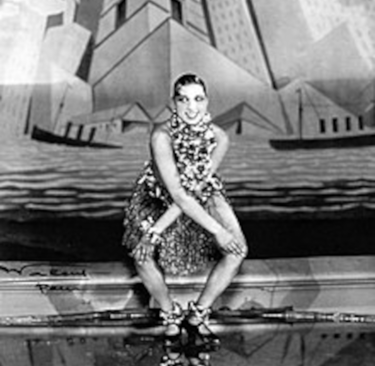
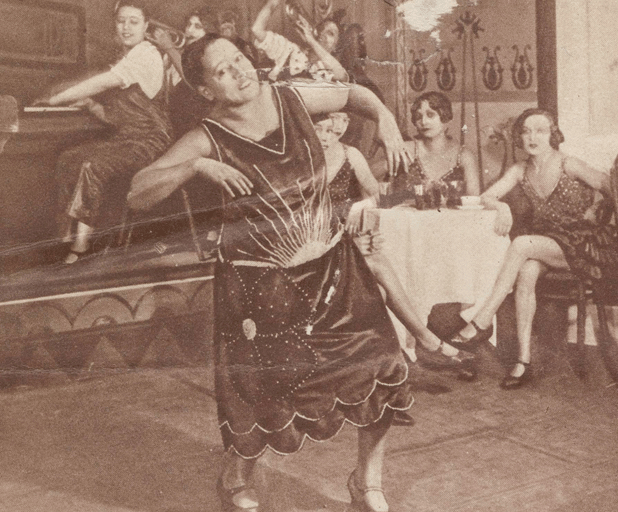

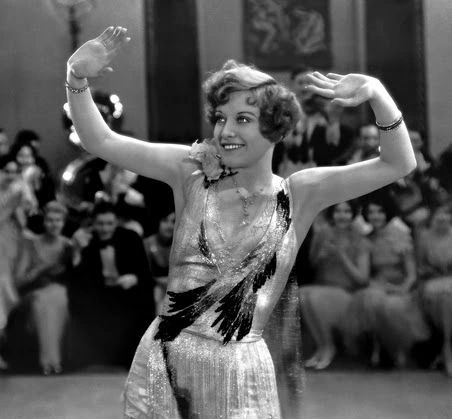


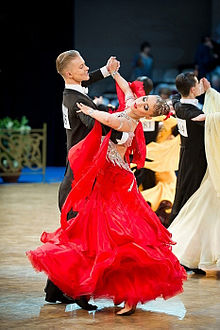
Several popular artists and bands were prominent in New York City during this time:
Duke Ellington: One of the most influential jazz musicians, Ellington became a mainstay at the famous Cotton Club in Harlem during the late 1920s.
Louis Armstrong: Although he started in New Orleans and Chicago, Armstrong was a major figure in the 1920s during the Harlem Renaissance.
Fats Waller: Born in New York City, Waller was a prolific Jazz Musician and Composer, credited with over 400 songs and writing music for Broadway Shows.
Paul Whiteman: Nicknamed the "King of Jazz," Whiteman was a popular white jazz artist who gained national fame during this era.
Bix Beiderbecke: A renowned Cornetist, Pianist, and Recording Artist known for his innovative Jazz Style.
Bessie Smith: Known as the "Empress of the Blues," Smith was a highly influential blues singer during the 1920s.
Cab Calloway: Though he rose to prominence in the early 1930s, Calloway began his career in New York during the Prohibition era.
Fletcher Henderson: A prominent Bandleader and Arranger in New York during the 1920s... he helped to define the sound of big band jazz.
King Carter was the first Texan Jazzman to make the big time.
Art Tatum: He was known as the “Ivory Wizard”, and his unique style combined Classical and Jazz Music.
Joe Venuti: In 1928, he performed with Singer Adelaide Hall at Harlem's Savoy Ballroom, where they introduced their classic “Dancing on the Ceiling” (Cover by Lionel Ritchie) with Louis Armstrong as the Trumpet Player.
Jack Teagarden Band: The Band made its debut at Reisenweber’s Cafe, where they played every week until 1918. Jack joined Al Jolson’s traveling show for two years as lead Guitarist and Vocalist before returning home, where he continued to perform at various Venues throughout Manhattan.
Tommy Dorsey: Up from Baltimore, he was the Leader of the Tommy Dorsey Orchestra.
Edward "Kid" Ory: He played with the New Orleans Rhythm Kings, one of the most famous New Orleans bands, and later joined King Oliver’s Creole Jazz Band... he also went on to play Europe.
Eddie Lang: He is most famous song is “Dinah”. It was originally written by composer Eubie Blake as a piano ragtime composition... which he first played in 1921 at the Clam House Café on West Coast 52nd Street in New York City... He is considered one of the Fathers of Jazz Guitar.
Hogie Carmichael: He wrote “Stardust” and "Georgia on my Mind"
Several popular Jazz Artists and Bands were active in Chicago during the Prohibition era (1920-1933):
Louis Armstrong: One of the most influential Jazz musicians of all time, Armstrong moved to Chicago in 1922 and made his first recordings there in 1923 with King Oliver's Band.
Joe "King" Oliver Creole Jazz Band: A prominent Cornetist and Bandleader who was a mentor to Louis Armstrong. He performed at venues like Lincoln Gardens.
Jelly Roll Morton: Left New Orleans to Los Angeles then formed his own Band called Red Hot Peppers in Chicago in 1917.
Isham Jones: Orchestra Leade
Ray Lopez: A New Orleans cornetist who was part of the Chicago music scene.
Duke Ellington: Considered one of the best jazz Songs is “Take the A Train”. This classic is a swinging tune that’s known for its intricate chord progressions and laidback rhythm.
Fats Waller: Another prominent jazz musician of the era, though not specifically tied to Chicago
Coleman Hawkins: After traveling around with several bands, he joined Fletcher Henderson’s group for a year before forming his own group with Don Redman and Louis Armstrong
Benny Carter: Jazz Musician and Bandleader playing Saxophone, Clarinet and a Flautist
Sidney Bechet: His Soprano Saxophone playing was a major force in developing the style and sound of Jazz, and he helped shape what became known as "Dixieland Jazz."
Ma Rainey: In 1917, Ma Rainey became the first woman to record the blues (and one year later, Bessie Smith would become the second)
Ethel Waters: She was an American Blues, Jazz, and Gospel Singer and Actress... her “smokey voice” was her trademark, and her singing style influenced many singers who followed her
Earl Hines: Played Chicago where he joined Fletcher Henderson’s band as its featured soloist on Piano.
Bubber Miley: The Clarinetist Bubber Miley was the first Jazz Musician to play the two-valve Instrument, which gave him a signature Sound.
Imbibing in the Roaring 20s
A growing temperance movement, from the late 1800s, blamed Alcohol for many societal ills, such as violence, disease, and inability to hold a job. in 1919, the passage of the 18th Amendment to the US Constitution was enforced by the "Volstead Act" beginning in 1920, which banned the production and sale of Alcohol in the United States. Thus began a dozen years of Prohibition, which was the common term for America’s “dry” era. The result was highly controversial, as many Americans quickly resisted having to give up their alcohol! Many Citizens, of all kinds, quickly found ways around Prohibition, ranging from secret bars known as speakeasies to buying illegal Beer and Booze from Bootleggers.
There was a delay between the
ratification of the 18th Amendment and
the implementation of the Volstead Act in
January 1920. This gave Americans
almost a year to stock up on alcohol, as
consumption of alcohol in private was not banned. As alcohol was "Prescribable as Medicine," many secured Prescriptions that would be legal during
Prohibition. However, tensions erupted as
soon as Prohibition began, especially
since many had not anticipated both beer and wine being banned along with the expected hard liquor. Protests rose up hoping to get Beer and Wine allowed whose Taxes could help fund the War... but to no avail.
While many Americans initially supported Prohibition for its potential health and behavioral benefits, a significant portion of the population soon began to resent the loss of Social Traditions, such as meeting Friends out at a Bar or Club. This resentment led to the swift emergence of Speakeasies - illegal Bars that required patrons to use passwords for entry... these were generally owned by the Mob. (see below)
These clandestine establishments were set up in various secret locations, including basements, warehouses, and even private homes.Interestingly, despite (or perhaps because of) their smaller size and covert nature, some historians argue that the actual number of drinking establishments increased during Prohibition. This ironic outcome suggests that the attempt to eliminate Alcohol consumption may have inadvertently led to its proliferation in more discreet forms.
The rise of Speakeasies illustrates how Prohibition, while well-intentioned, resulted in unexpected Social adaptations and potentially increased the very behavior it sought to curtail. This phenomenon highlights the complex relationship between Legislation and Social behavior, demonstrating how attempts to regulate personal habits can lead to unforeseen consequences.
The clandestine nature of Speakeasies may have inadvertently increased alcohol consumption among women during the 1920s. Prior to Prohibition, there was a significant social stigma surrounding women drinking in public. However, the illicit nature of speakeasies created a more level playing field; men who frequented these establishments were less likely to criticize women for engaging in the same prohibited behavior.This shift coincided with a broader movement towards women's independence and empowerment, exemplified by the iconic "flapper" of the 1920s.
Women were increasingly asserting their autonomy in various ways:
Fashion: Adopting shorter skirts and more revealing clothing
Transportation: Driving their own automobiles
Personal habits: Smoking cigarettes more openly
Political engagement: Exercising their newly acquired right to vote, following the ratification of the 19th Amendment in 1920
In this context of rapidly evolving social norms, a woman's presence in a speakeasy became less shocking than it might have been in previous decades. The combination of Prohibition's unintended consequences and the broader push for women's liberation created an environment where Women could more freely participate in drinking culture, albeit in these illicit settings.
During Prohibition, the illicit transportation of alcohol to speakeasies and individual consumers gave rise to a new breed of smugglers known as bootleggers. These individuals specialized in covertly moving alcohol, often using vehicles with hidden compartments. A subset of bootleggers, known as rumrunners, focused on smuggling alcohol, particularly rum from the Caribbean, via maritime routes.The Prohibition era fortuitously coincided with the advent of mass automobile production, making cars more affordable and accessible. Bootleggers quickly capitalized on this technological advancement, modifying their vehicles to better suit their clandestine activities.
These modifications, colloquially known as "souping up," included enhancing Engine performance for increased speed, adjusting axles and shocks for improved handling, and upgrading tires for better traction on unpaved Roads
These improvements were designed to outmaneuver and outrun Law enforcement, particularly on rough, rural roads, especially in North Carolina. The Bootleggers' need for speed and agility in their vehicles inadvertently laid the groundwork for what would become auto racing in the United States. (Junior Johnson and the Petty Family were Pros at the Craft)
Prohibition's ban on the production, distribution, and sale of Alcohol created a lucrative opportunity for Organized Crime (The Mob) syndicates. Operating Speakeasies required two crucial elements: a consistent supply of high-quality Hard Alcohol and Beer and protection from both rival Gangs and Law Enforcement raids. The Mob, was well-positioned to meet these demands due to their extensive resources and manpower.
Also, the Mob's financial power and intimidation tactics allowed them to bribe local law enforcement, ensuring that popular Speakeasies could operate with minimal interference. This symbiotic relationship between organized crime and corrupt officials became a hallmark of the Prohibition era.
Among the many criminal figures who rose to prominence during this time, Chicago Gangster Al Capone stands out as the most infamous. Capone was known for his brazen public persona and audacious actions. However, his notoriety was also rooted in his violent methods, particularly in his aggressive competition for territory with rival Gangs.
These turf wars escalated with the introduction of deadly new weapons, such as submachine guns. Originally developed as "Trench Sweepers" during World War I, these Weapons found a new and sinister purpose in the hands of Gangsters. The resulting violence reached unprecedented levels, transforming parts of Chicago into Urban Battlegrounds.
Chicago's streets, illustrating the extent and sophistication of the bootlegging operations during Prohibition.


Popular Songs from the 1920's
1920 - Dardanella - Ben Selvin... Crazy Blues - Mamie Smith... Whispering - Paul Whiteman...
Love Nest - John Steel... Swanee - Al Jolson
1921 - Margie - Eddie Cantor... Look for the Silver Lining - Marion Harris... The Wabash Blues - Isham Jones... All by Myself - Ted Lewis... Wang Wang Blues - Paul Whiteman,
1922 - April Showers - Al Jolson... My Buddy - Henry Burr... Hot Lips - Paul Whiteman...
On the Alamo - Isham Jones... Toot, Toot, Tootsie - Al Jolson
1923 - Love Her by Radio - Billy Jones... Georgia Blues - Ethel Waters... Felix the Cat - Paul Whiteman...
That Old Gang of Mine - Billy Murray... Dreamy Melody - Art Landry
1924 - The Prisoner’s Song - Vernon Dalhart... It Had to Be You - Isham Jones...
King Porter Stomp - Jelly Roll Morton... Jealous - Marion Harris... Rhapsody in Blue - George Gershwin
1925 - Dinah - Ethel Waters... St. Louis Blues - Bessie Smith... Sweet Georgia Brown - Ben Bernie...
Remember - Isham Jones... Yes Sir...That’s My Baby - Ace Brigode
1926 - Bye Bye Blackbird - Gene Austin... Some of These Days - Sophie Tucker... Rio Rita - Nat Shilkret... Always - Vincent Lopez... Heebie Jeebies - Louis Armstrong
1927- I’m Coming, Virginia - Bix Beiderbecke... Stardust - Hoagy Carmichael... Lucky Lindy - Nat Shilkret... Shaking the Blues Away - Ruth Etting... Black & Tan Fantasy - Duke Ellington
1928 - My Man - Fanny Brice... I Wanna Be Loved By You - Helen Kane... Makin’ Whoopee - Eddie Cantor...
The Man I Love - Marion Harris... Ol’ Man River - Paul Robeson
1929 - When You’re Smiling - Louis Armstrong... Tip Toe Thru’ The Tulips - Nick Lucas...
Maybe, Who Knows? - Kate Smith... Dream Lover - Jeanette MacDonald... Ain’t Misbehavin’ - Fats Waller
In Summary
In Part #7A, we learned how the effects of Prohibition changed the course of Music Evolution...
One of the most significant effects of Prohibition on Music was the rise of Speakeasies. These illicit establishments became the epicenters of a thriving underground Nightlife, providing a unique space for musical experimentation and performance. Jazz, which had already begun to emerge as a distinct Genre, found a natural home in these clandestine Venues.
The intimate and often crowded nature of Speakeasies encouraged the development of smaller ensembles and a more improvisational style of playing, which became hallmarks of Jazz music. The Speakeasy culture also played a crucial role in breaking down of some Social barriers. These Venues often brought together People from diverse backgrounds, including different Races and Social Classes, in a way that was unprecedented for the time. This mixing of cultures and ideas contributed significantly to the evolution of Jazz and other musical forms. Some Clubs became known as "Black and Tan" Establishments, featuring multiracial Crowds and Performers, which was a radical concept in an era of widespread Segregation.
Prohibition inadvertently provided a boost to the careers of many influential Musicians. Gangster-owned Speakeasies competed for the best Performers, advancing the careers of artists like Louis Armstrong, Duke Ellington, and Fats Waller. This patronage system, while problematic in many ways, provided steady work and exposure for musicians, allowing them to hone their craft and develop their unique styles. The era also saw the emergence of new Dance Styles that were closely tied to the Music of the time.
Dances like the Charleston, the Black Bottom, and the Lindy Hop gained popularity, often shocking older generations with their energetic and sometimes provocative movements. These dances reflected the spirit of rebellion and liberation that characterized the Roaring Twenties. Technologically, the 1920s saw advancements that further propelled the evolution of Music. The widespread adoption of Radio and affordable Phonographs revolutionized Music consumption, making Jazz and other forms of popular Music more accessible to a broader audience. This increased exposure helped solidify jazz's place in American Culture and contributed to its rapid evolution.
It's important to note that while Prohibition provided a unique backdrop for Musical innovation, it was part of a broader context of Social change in 1920s America. Urbanization, technological advancements, and shifting Social norms all contributed to the cultural ferment that characterized the decade. The end of Prohibition in 1933 did not mark the end of its influence on Music. it would begin to "Rock On" after "Swinging Around."
The Musical Styles and Cultural changes that emerged during this period continued to evolve and shape American Music for decades to come. The legacy of Prohibition can be seen in the enduring popularity of Jazz, the continued evolution of Dance Music, and the lasting image of the Speakeasy as a symbol of Musical Rebellion and Creativity.
*************
In Part #8, we deal with the impact of the "Great Depression" and how music was instrumental of helping the Masses through the pain of the Times... and the Birth of "Swing Music"
© ClassicRockTurntables.com
All Rights Reserved
